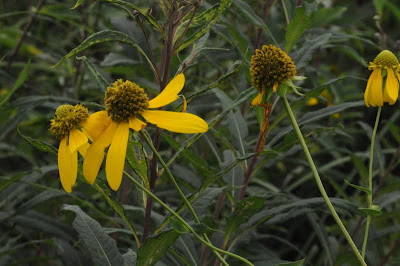It's a Tuesday morning, which means a group is here to walk the trails and get some natural history learning. I wanted to release the stinkpot (see update in previous post), so joined the group this morning. The group's goal this morning was to find more monarch butterfly eggs on the milkweeds out in the prairie, so I knew we'd be looking at flowers. Here are a few quick snapshots of what we saw:
First up, green-headed (or tall) coneflower.

I've been wondering how to tell the green-headed from the grey-headed, because to me, they both have sort of greenish centers. It turns out that the green-headed has shorter, fatter centers, and the petals don't "blow back" anywhere near as far as they do on the grey-headed. Mystery solved!
Tick trefoils are out and blooming quite well right now. A couple of us had out our Newcomb's and were trying to figure out which one this was. We think it is panicled, another native!
This lovely purple flower had us all scratching our heads for a while. It's not in Newcomb's. However, I took out my Michigan Wildflowers book when I got back to the office and there it was.
This is field milkwort. What a lovely, lovely flower. And it doesn't look at all like racemed milkwort, the first milkwort I met, which looks a lot like gaywings. The only similarity between this milkwort and that is the color! Still, they are in the same family, so there must be some other traits they share, like the narrow leaves.
Tall sunflower - not necessarily as tall as you might think from the name. These small-flowered sunflowers are quite beautiful and blend in with all the other coreopsises (coreposii?) and yellow-flowered prairie plants. One needs a keen eye, a good field guide, and a sense of curiosity to get out and find the differences.
We didn't ID this little sunflower.
Here's the coreopsis I noted last week (perhaps on the Dahlem blog). Turns out, it is called oxe-eye, and shouldn't be confused with oxe-eye daisy, which is an entirely different plant. Oxe-eye is also known as false sunflower (why, I don't know, because it is in the sunflower family). This one also had us on a merry chase to try and ID.
And, it turns out the ironweed is indeed New York ironweed, not common ironweed. Huzzah!







Nice to see all those showy flowers. Thanks for the tour. By the way, that Field Milkwort is included in Newcomb's under the common name of Purple Milkwort (Polygala sanguinea) on p. 46. Also, the Oxeye can be distinguished from "genuine" sunflowers by the tiny forked pistil at the base of each ray flower. With sunflowers, only their disk flowers are pistillate. I have to look that information up every year when I find Oxeyes blooming, usually not until September here. I don't think we have Gray Coneflowers in northern NY, just the Green-headed ones, which are in showy array along the Hudson now, fronted by the brilliant Cardinal Flowers. Wish we could go for a paddle there together.
ReplyDelete